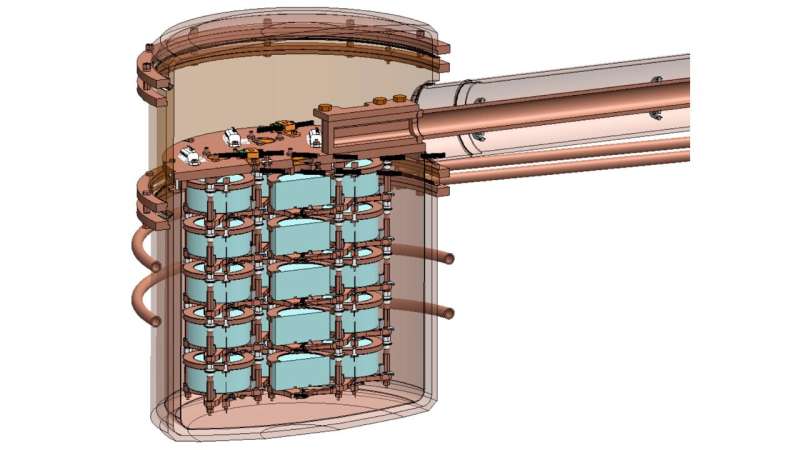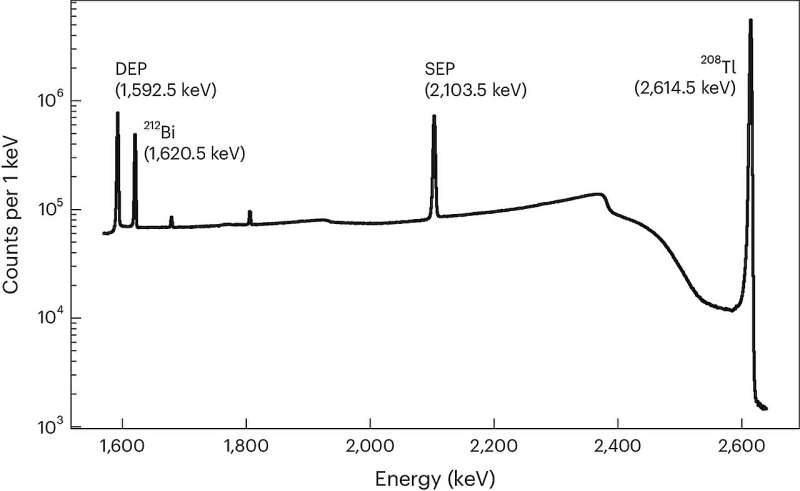In a new study published inNature Physics, scientists at the MAJORANA Collaboration have tested the stringency of charge conservation and Pauli’s exclusion principles using underground detectors. Alessio Porcelli has published a News & Views piece on the research in the same journal.
Today, the Standard Model of particle physics is one of two pillars on which modern physics rests. It successfully explains three out of the four fundamental forces and how subatomic particles behave.
Pauli’s exclusion principle and the conservation of charge are two of the principles arising from the symmetries in the Standard Model. They have withstood many theoretical challenges and have repeatedly proven to the point where they are considered axiomatic.
Now, researchers believe that small violations of these principles could lead to physics beyond the Standard Model, such as exotic forms of matter.
The MAJORANA Collaboration is one such experiment. The project aims to explore neutrinoless double beta decay, a type of radioactive decay, hoping to establish if neutrinos are Majorana particles.
The research is an international collaboration of scientists, including Dr. Clint Wiseman from the University of Washington and Dr. Inwook Kim from Lawrence Livermore National Laboratory in California, who co-authored the Nature study.
Speaking to Phys.org, Dr. Wiseman shared his motivation behind this pursuit, “When I first learned quantum mechanics, I was taught to question things presented as unshakable principles. The principles of quantum mechanics—the bedrock of the Standard Model—are heavily ingrained in us because they have borne out to be true again and again.
“As we look for areas of new physics to explore in the 21st century, it can be worthwhile to go back to those principles and attempt to push the limits of their correctness.”
Symmetries, conservations and Majorana particles
The deep connection between symmetry and conservation laws was revealed by the mathematician Emmy Noether. According to Noether’s theorem, every conservation law is deeply connected to an underlying symmetry in nature.
“Our inability to create or destroy charge without accounting for it elsewhere is related to a symmetry of this kind. The inability of more than two electrons to share the same quantum state represents an equally important anti-symmetry of nature that plays an essential role in the large-scale behavior of atomic matter,” explained Dr. Wiseman.
If these principles were shown to be violated, it would mean the breaking of fundamental symmetries.
“The fact that the photons are experimentally verified as massless is often considered the evidence that the charge conservation fundamentally holds. However, theoretical extensions of the Standard Model, like certain quantum gravity models, could potentially include mechanisms that violate charge conservation.
“The Pauli exclusion principle is mathematically derived directly from the antisymmetric property of fermionic wavefunctions. As in the case of charge conservation, this could be violated in a beyond-the-standard-model framework,” Dr. Kim told Phys.org.
How does this relate to the work being done by the MAJORANA project? The Majorana particle, if it exists, would be its own particle. This is, at the moment, purely conjecture, but the neutrino might fit the description.
The neutrino is a very elusive particle, making it difficult to detect and study its properties. One of the things scientists have been unable to establish is whether it is its own antiparticle, i.e., a Majorana particle.
The MAJORANA project is working towards this goal by searching for an ultra-rare process known as neutrinoless double beta decay.
Beta decay and underground detectors
Beta decay, as mentioned earlier, is a radioactive decay process. In this process, neutrons decay into protons, positrons (which are known as beta particles and are the antielectrons), and antineutrinos.
The MAJORANA DEMONSTRATOR consists of highly pure germanium (Ge) detectors deep underground to avoid radiations, such as cosmic rays, which could interfere with it. The Ge detectors are highly sensitive to energies released during these beta decay reactions.
In a double beta decay, we have two beta decays happening simultaneously, and we get two antineutrinos along with the protons and beta particles. However, in the neutrinoless case, we would observe no neutrinos, as the name suggests.
This is because if the neutrino were a Majorana particle, the neutrino from one beta decay would cancel out the emissions from the antineutrino (from the other decay), resulting in no neutrino emissions, which the MAJORANA demonstrator is set to detect.
The dataset taken by the detector array formed the basis for the researchers to study the limits of the charge conservation and Pauli’s exclusion principle.

Testing the limits
The researchers focused on three scenarios, with the first one testing charge conservation and the other two testing Pauli’s exclusion principle.
Let’s start with the first test: charge non-conservation. In this scenario, the researchers were exploring electron decay within a Ge atom. If an electron were to decay, it would leave a vacancy in the atom’s orbital, which is filled by an electron from a different orbital.
This process results in the emission of a photon or X-ray, indicating that the charge is balanced. However, the lack of emission would indicate a non-conservation of charge.
For the case of Pauli’s exclusion principle, the researchers focused on type I and type III interactions of fermions (in this case, electrons).
In type I interactions, we have interaction between a newly created electron and a system of fermions. This electron is created using pair production from gamma rays.
The aim was now to observe if this newly created electron would occupy a fully completed atomic orbital (as is the case for Ge atoms), violating Pauli’s exclusion principle about fermions occupying the same state. If this did indeed happen, they would observe an X-ray emission.
For the final scenario, type III interactions, the interactions are between fermions in the same system, i.e., electrons within the Ge atom. If an electron were to transition from its orbital to another filled orbital unexpectedly, a photon or X-ray would be emitted, and Pauli’s principle would be in violation.

Setting new constraints and forming LEGEND
The researchers found that all three scenarios panned out as they were supposed to, with no violations.
“We found no evidence that the principles are violated, setting more stringent limits on new theories of physics. The charge conservation limit is the most stringent of its kind since 1999,” said Dr. Wiseman.
The limit Dr. Wiseman is referring to here is on the mean lifetime of the electron decaying to three neutrinos (or dark matter), which they established to be greater than 2.83 × 1025 years, indicating the high stability of electrons.
Further, Dr. Kim added, “Our finding of no signature suggests that these two principles hold to a very high precision—at least to the extent that current state-of-the-art technology can detect. This further strengthens our confidence in the validity of these principles.”
The MAJORANA DEMONSTRATOR dataset proved to be incredibly versatile. The experiment is expanding by forming a larger collaboration called LEGEND by merging with another Ge-based detector, Gerda.
“By operating high-resolution germanium detectors in an ultraclean environment, LEGEND will further investigate various unexpected signatures from beyond the Standard Model physics,” said Dr. Kim.
Dr. Wiseman concluded by saying, “The current results validate quantum mechanics’ accuracy and provide more stringent constraints on future efforts to construct new theories of physics. This will require more imagination, or as Feynman put it: imagination in a straitjacket.”
More information:
Search for charge non-conservation and Pauli exclusion principle violation with the Majorana Demonstrator, Nature Physics (2024). DOI: 10.1038/s41567-024-02437-9
Alessio Porcelli, Search for rule-breaking electrons, Nature Physics (2024). DOI: 10.1038/s41567-024-02448-6
© 2024 Science X Network
Citation:
Scientists at the MAJORANA Collaboration look for rule-violating electrons (2024, April 24)
retrieved 24 April 2024
from
This document is subject to copyright. Apart from any fair dealing for the purpose of private study or research, no
part may be reproduced without the written permission. The content is provided for information purposes only.
Reference :
Reference link

























+ There are no comments
Add yours